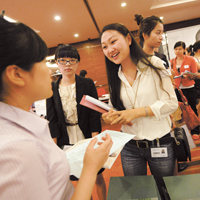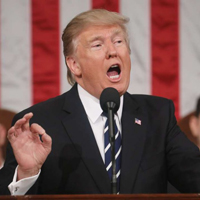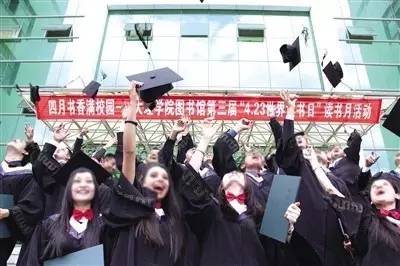- 当前位置:
- 首页>
- 活动>
- ���������������
���������������
CCG持续关注国际关系议题,推动中国与全球化的发展,积极开展国际交流,充分发挥智库“二轨外交”作用,在巴黎和平论坛、达沃斯世界经济论坛、慕尼黑安全会议等重要国际政策与意见交流平台上组织分论坛、边会、圆桌会议、晚宴等活动,促进国际政商学界对话,凝聚共识;CCG积极与各国政界、智库界、工商界开展“二轨外交”活动,每年常态化赴多国调研与交流,促进中外关系攸关方互动,保持与多国政策圈层的沟通渠道。
-
张蕴岭:通过新机制创造新动能
专家简介张蕴岭,全国政协委员,中国与全球化智库(CCG)学术专家委员会专家,中国社会科学院学部委员。 日前,全国政协委员、中国社会科学院学部委员张蕴岭接受《中国日报》采访,展望2017年中国外交。 对于中国今年主办“一带一路”国际合作高峰论坛和金砖国家领导人第九次会晤,张蕴岭表示:“当前世界经济处在一个恢复的过程,还很艰难,这个时候中国通过推动‘一带一路’、金砖合作以及去年举办G20,为世界经济恢复增长提供新的动力。” 张蕴岭说:“因为从目前和今后看,世界增长最大的潜力还在于发展中国家,而发展中国家的发展还在于综合发展环境的提升,包括基础设施、产能构造等方面的提升,要帮助它们有能力发展起来。” 谈到去年英国“退欧”公投等事件,张蕴岭认为,当保守主义、内向主义、单边主义成为政治潮流的情况下,一些西方国家着重于自身发展,而恰恰是中国在通过新机制创造新动能。 张蕴岭说:“金砖、一带一路,还有RCEP(区域全面经济伙伴关系),都是一种基于开放、发展的战略,都不是封闭保守的战略。在出现退全球化、反对进口、鼓励出口的保护主义的情况下,我们推动的都是开放的。” 张蕴岭指出,中国作为世界第二大经济体,其经济增长占世界40%,中国到目前推的都是开放、合作、发展的、大的举措,在退全球化、保护主义抬头的当口,中国不是要“当头儿”,而是中坚力量,是引领着大家走。 对于当前中国经济,张蕴岭认为,中国经济正处在一个关键阶段。他说:“中国经济还处在调整期,中国主办这些活动也是要推动改革开放和转型……中国的调整,是通过和别人合作来加快转型,也叫‘合作型’的转型。文章选自中国日报网,2017年3月4日
2017年3月7日 -

【The Wall Street Journal】China Economy Draws More Students Back From Abroad
Beijing trumpets return of “sea turtles,” the thousands of students who left China to study abroad, but many may not have much choiceBEIJING: In recent years, Chinese students have increasingly opted out of the education system at home and gone abroad. Now, as China is eager to point out, a greater share of them are also coming back.“A hundred rivers eventually return to the sea, it’s the right time to build a dream together” read a recent headline in the Communist Party’s flagship newspaper, the People’s Daily, which declared the number of returning students to be the largest in history.But while the flood of haigui, or sea turtles, as they are known in Chinese, is a source of pride, it may not be patriotism or even economic opportunity driving the trend, but more practical matters like visas. And not everyone is joining in.A rise in incomes and frustration with China’s ultracompetitive education system produced a study-abroad fervor of historic proportions. The figure reached over half a million in 2015, more than 13 times the level in 2000, according to official statistics.In recent years, around 80% of such students have returned home, compared with about a third in 2006, according to the Education Ministry.One reason is that today’s crop skews more heavily undergraduate. In the past, students more typically were studying for doctorates or similarly advanced degrees that would have made landing a job abroad easier.There also are legal factors. In the U.S.—which polls show is the most popular destination for Chinese students—demand for H-1B skilled-worker visas has vastly outstripped supply for years, even for those with job offers.Those who don’t get a visa have to seek other options, such as applying to another degree program, or go home.China also has tried to entice students back by establishing industrial parks aimed at incubating startups led by returnees. While in 2000 China was home to around 50 such parks, today there are more than 300, though returnees cite bureaucratic challenges in accessing such resources.Beijing and other cities also dangle the offer of a coveted local residence permit, which confers a host of social benefits, for those with advanced degrees from overseas.A strong startup culture has taken hold in recent years, spurred in part by larger-than-life internet entrepreneurs such as Jack Ma, founder of Alibaba Group Holding.“China offers a lot of high-tech opportunities—like mobile internet, science and entrepreneurship—so it seems the opportunities, if not equal, can be even better than in the United States,” said Wang Huiyao, president of the Center for China and Globalization (CCG) think tank, and vice chairman of the China Western Returned Scholars Association.Feng Feng, 31 years old, returned with a master’s degree in education from the University of Pennsylvania in 2014 to found an education-consulting company in Beijing.Most of her Chinese friends in the U.S. also returned home, she said. “It’s easier to get a job in China,” she said.According to a 2016 survey by Mr. Wang’s think tank, around three-quarters of returnees make at least 5,000 yuan ($730) a month, with a quarter making more than 10,000 yuan.That beats the average monthly salary for domestic college graduates half a year after leaving school of 3,487 yuan, according to government statistics.But salaries are generally higher in the West, and the cost of a foreign education is a lot to recoup.With more overseas graduates returning and looking for work, competition has stiffened. These days, job-hunting haigui down on their luck are also known as haidai, or seaweed. And there are other factors to consider.Dezhi Fang, a 19-year-old junior at the Georgia Institute of Technology, said that between government incentives and business opportunities, the climate for returnees has greatly improved.But Mr. Fang, who is studying computer science, said that in the U.S. he has access to sources of research funding he wouldn’t be able to tap in China, and that China’s internet censorship is also a deterrent. “All my networks, both in academia and industry, are in the U.S.,” he said.He plans to stay after graduation to pursue either a doctorate or a job in the tech industry. Most of his Chinese friends also want to stay, he said.“The U.S. is still the greatest place for doing cutting-edge research,” he said.Chinese media last week trumpeted how 94-year-old Nobel laureate Chen Ning Yang and Turing Award winner Andrew Yao, 70, recently gave up their U.S. passports to take up Chinese citizenship again and join the Chinese Academy of Sciences.Back in Beijing, Ms. Feng, whose company helps advise Chinese firms on how to build education partnerships in the U.S., said she partly let her palate decide: “I don’t like food in the U.S.—too many sweet things and too much cheese.”(By Te-Ping Chen)From The Wall Street Journal,2017-3-1
2017年3月6日 -
宗庆后:建议在浙江设杭州知识产权法院
宗庆后,中国与全球化智库(CCG)副主席,杭州娃哈哈集团有限公司董事长。 第十二届全国人民代表大会第五次会议将于3月5日开幕。 日前,澎湃新闻(www.thepaper.cn)获悉,全国人大代表、杭州娃哈哈集团有限公司董事长兼总经理宗庆后将向大会提交《关于在杭州设立知识产权法院的建议》。 宗庆后表示,在全国人大常委会的支持下,北京、上海、广州相继设立了知识产权法院,对当地知识产权司法保护发挥了十分积极的作用。结合浙江经济社会发展的实际情况和知识产权司法保护的状况,建议在浙江设立杭州知识产权法院,以充分保障各类知识产权,促进浙江创新型经济更上一个台阶。 对于作此建议的理由,宗庆后表示,首先,浙江创新经济的快速发展需要加大知识产权的保护力度。浙江省已经成为了国内领先的创新大省、制造业大省,民营经济十分发达,知识产权的投入和产出获益明显。根据相关部门的统计资料显示:2016年浙江省新增发明专利授权量2.66万件,每万人口发明专利拥有量16.5件,位居全国前列;2016年商标申请量327572件,位居全国第三,有效注册商标量1315742件,位居全国第二。 其次,知识产权法院的设立不仅能有效满足浙江省知识产权司法保护需求,也能与浙江目前高水平的知识产权司法保护状况相适应。由于浙江省专利、商标、著作权以及商业秘密等知识产权发展迅速,与之相对应,浙江省知识产权司法保护需求量不断增长,知识产权民事纠纷数量也一直保持在高位运行。据了解,近五年来,浙江省法院受理各类知识产权民事一审案件76127件,审结74537件,收结案数均位居全国前列,而且有十多起案件已经入选了全国法院十大知识产权案件和五十个典型案例。而浙江法院审理的一些知识产权案件,不仅在国内,在国际上也具有极大的影响力。 此外,杭州具有设立知识产权法院的区域优势。杭州不仅是首批国家知识产权示范城市,还是国家科技和金融结合示范城市、国家级文化和科技融合示范基地。设立杭州知识产权法院,可以在提升杭州投资软环境和区域竞争优势的同时,引领浙江全省创新经济的发展,为浙江经济转型升级提供有力的司法保障。 据了解,杭州地区已有7家基层法院具有部分知识产权案件管辖权,审理的多起案件特别是专利类案件入选了全国法院十大知识产权案件和50个典型案例。而杭州中院知识产权审判庭通过推进司法改革,打造了以知识产权员额法官为核心、技术类案件审判经验丰富的专业审判团队,为设立杭州知识产权法院提供了基础人才保障。文章选自澎湃新闻网,2017年3月3日
2017年3月6日 -

【South China Morning Post】Beijing ’should mark’ Trump’s words
US president displaying neither friendship nor weakness, but is constantly testing Beijing’s bottom line, says trade expertUS president Donald Trump’s latest accusation that China is causing massive American factory closures should be a signal for the Chinese to be vigilant, mainland trade experts say.During his first address to the Congress on Tuesday, Trump announced plans for massive military expansion, reiterated his stance against terrorism, called for a “merit-based” immigration system and pledged a threefold increase in new infrastructure.In particular, he again described how international trade had damaged the US economy, and talked of imposing taxes and tariffs on other countries’ imports to strengthen America’s trade position, without giving details.“We’ve lost more than one-fourth of our manufacturing jobs since NAFTA was approved, and we’ve lost 60,000 factories since China joined the World Trade Organisation in 2001,” he told the Capitol.“Currently, when we ship products out of America, many other countries make us pay very high tariffs and taxes – but when foreign companies ship their products into America, we charge them almost nothing,” he said.Having heard that, Huo Jianguo, vice-chairman of the Ministry of Commerce’s China Society for WTO Studies, said Beijing should be mentally and practically prepared for the coming trade friction with the US, which was only a matter of time and scale.Unilateralism and protectionism had been the central concept of Trump’s view on trade, as well as his voter base, said Wang Huiyao, president of the Center for China and Globalization (CCG) and an adviser to the State Council.“China’s contribution to the creation of new US jobs and to maintaining low consumer prices for years has been ignored by him,” said Wang. “And this has been his long-held idea.”Although his ideas and personality has never changed, Trump has in fact displayed significant flexibility in terms of dealing with China, such as making no moves on his highly publicised policies during his election campaign such as slapping a 45 per cent border tax on Chinese goods or declaring China a currency manipulator, Huo said.He also stepped back and reaffirmed to president Xi Jinping the US commitment to the one-China policy, which he originally indicated might be up for negotiation.“He isn’t showing friendship, nor weakness. He has been constantly testing Beijing’s bottom line,” Huo said.After his telephone conversation with Xi two weeks ago, Trump yesterday met state councillor Yang Jiechi, who is likely to organise a face-to-face meeting of the two leaders.Keeping contact while making complaining in public was also a negotiation tactic of the “dealmaker” Trump, Huo suggested.As Trump continued to assess and shape his trade policies, China should increase contact and communication with his administration but be willing to take the trade fight to the Americans without sacrificing the relationship, he said. (By Liu Zhen)From South China Morning Post,2017-3-1
2017年3月6日 -

【The Star Online】New Chinese green card plan gets green light
Beijing: To attract more global talent and investments, China plans to introduce a new green card that will be more widely recognised to make life easier for permanent residents (PR), whose numbers are still very small in the country.But some PRs said that the new card, to be introduced by the end of this year, is not vastly more attractive and may not help the world’s second largest economy turn into a magnet for foreign professionals and funds.A meeting of the Central Leading Group for Comprehensively Deepening Reforms chaired by President Xi Jinping earlier this month called for further reforms in China’s immigration policy.“The reforms should serve the country’s talent development strategy, address public concerns, optimise the design of the card and improve the information system,” according to a statement released by Xinhua news agency.“This simply means the card will be made more useful,” said Dr Wang Huiyao, president of the Centre for China and Globalization (CCG) .“Currently, the card is not included in China’s identification card system. So it is not possible for green card holders to use their cards like how Chinese citizens use their identification cards,” he said.In theory, foreigners holding the green card have the same rights as Chinese citizens, except for political ones.The card, renewable every five or 10 years, allows PRs to live in China without a visa, buy property and enrol their children in public schools.Card holders are also covered by social insurance, and those who are unemployed can receive pensions and health insurance.But, in reality, PRs in China say the document is not well recognised in the country, and they could not use it in most situations.And most PRs do not try to claim the social benefits as their expatriate packages usually cover housing, education and insurance for themselves and their dependants.Introduced in 2004, the Chinese green card is thought to be one of the hardest to get worldwide, because of its complicated application process and high threshold for qualification.By 2013, only 7,356 foreigners had become Chinese PRs, out of the more than 600,000 foreigners living in China.From The Star Online,2017-2-28
2017年3月6日 -

【北京晚报】智库建议放宽留学生在华工作限制
进一步放宽永久居留申请条件、放宽留学生在华工作和实习限制、进一步加大留学生工作签证的发放力度……这是中国与全球化智库(CCG)日前发布的《抓住美国移民收紧机遇 更加开放国际人才政策》研究报告的建议。 据介绍,基于对中美两国国际人才政策的长期跟踪研究,CCG针对性地提出开放国际人才政策十项建议,旨在建立更加开放、包容和灵活的国际揽才机制,实现我国在国际人才竞争中的后起超越。 报告对美国移民体系、移民政策进行了梳理,并对美国总统特朗普移民政策态度、原因和国际社会反应进行了分析。报告指出,在历史上,美国就是一个建立在移民基础上的国家,而且移民已经成为美国科技创新的重要力量,其获得的创新专利量占据了总量的 1/3。尤其在互联网科技浪潮中,那些具有移民家庭背景的人才为美国科技创新贡献了重要力量。高科技精英们集体抵制特朗普的移民新政,正是因为不希望美国因为限制移民而丧失曾经拥有的核心优势。 报告同时分析了中国移民签证制度改革现状与发展。自2015年7月起,京、沪、闽、粤等地相继出台了更加开放、灵活的涉及外国人签证、停留居留证件和永久居留证签发等出入境政策措施。2017年2月6日,中央全面深化改革领导小组第三十二次会议指出,“实施外国人永久居留证件便利化改革,要围绕服务国家人才发展战略,回应社会关切,在优化证件设计、改造信息系统等方面推进改革,着力解决外国人永久居留证可识验和便利化问题,推动永久居留外国人在华资格待遇落实。” 报告指出,美国移民政策的收紧对于正面向世界建立开放、包容和灵活揽才机制的中国而言实则是一个重大机遇,但中国目前存在的“绿卡”申请条件过严、相应法律法规和管理、服务机构缺失等问题,相对又削弱了中国的国际人才竞争优势。 最终,报告从签证、永居、移民法、移民局等八方面提出了对策建议,希望建立更加开放、更具吸引力的国际人才竞争制度,实现我国在国际人才竞争中的后起超越。具体建议包括:进一步放宽永久居留申请条件、进一步提前“绿卡”发放时间、建立永久居留转入籍制度、建立与国际无缝衔接的外籍人才社会保障体系等。(本报记者 郑勇)文章选自《北京晚报》,2017年3月1日
2017年3月6日 -
Long Yongtu: New globalization trends in Chinese firms
Long Yongtu, chairman of Center of China & Globalization (CCG). He was China's chief negotiator when the country sought to enter into WTO.With its outbound direct non-financial investment reaching a record high of US$145.67 billion in 2015, China's accumulated outbound direct investment, for the first time, stood above US$1 trillion by the end of 2015. In 2016, several major deals were announced, including Midea Group acquiring German robot maker Kuka for more than 4 billion euros, and ChemChina's US$43 billion takeover of Swiss group Syngenta. Such direct Chinese investment in foreign countries has expanded almost ten times in the past decade, and the fields of investment and destinations of companies that go overseas have become more diversified.China is a large beneficiary of globalization. It became the world's second largest economy in 2010 and the world's largest trading nation in 2013.A foreign cargo ship is seen at Qingdao Port in east China's Shandong Province, December 8, 2016. China's exports in yuan terms ended previous drops to rise 5.9 percent year on year in November, while imports continued to pick up steam by increasing 13 percent, customs data showed on December 29, 2016 (XINHUA)But the world's globalization process seems to have decelerated since the financial crisis in 2008. Official data shows that global trade increased only 2.8 percent year-on-year in 2014, marking the first time that the trade growth rate was lower than that of GDP. The number of protectionist measures introduced by G20 countries skyrocketed from 381 items in 2010 to 1441 in late 2015. And after the shocking exit from the EU by Britain, most of the presidential candidates and later the president-elect of the United States opposed the Trans Pacific Partnership, which was believed to be a facilitator of freer trade in the Asia Pacific.But in my opinion, these are only temporary phenomena in the economic cycle and do not represent long-term global trends. There are three factors in globalization. First, the rapid development of science and technology; second, international investment and trade by multinational companies; and third, industrial structural adjustment around the world. So long as these factors are still in full swing, the process of globalization will not be stopped.Chinese firms are now in the period of globalization. Though they are sometimes believed to have little core technology and low profit, they are bound to develop further and show the following trends.First, Chinese companies that "go global" will see rapid growth. China's outbound direct investment will double to between US$250 billion and US$300 billion by the end of 2020, and total outbound direct investment during the 2016-2020 period is expected to reach US$1.1 trillion.Second, the globalization of Chinese firms will help upgrade Chinese industries. Since its entry into the WTO, China has made a lot of effort in increasing the technology and additional value of its exported goods. High-tech goods contributed 17.5 percent of the worth of all exported goods in 2001, and the figure climbed to about 30 percent in 2016. Midea's acquisition of Kuka in May last year was aiming at increasing its own productive efficiency and upgrading its manufacturing ability by using Kuka's advanced technology in industrial robots and automation. Cases like this prove that Chinese firms are trying to acquire patented and core technologies in the process of globalization, which will also help China become a manufacturing powerhouse.Third, Chinese firms are becoming more diversified in their global expansion. After gaining a foothold in some of the world's most popular investment destinations in the past one or two decades, Chinese companies are now exploring emerging destinations and are thus more diversified than they used to be. For example, since first going overseas in 1997, Huawei now has branches or offices in more than 160 countries.Fourth, Chinese firms will move up the value chain in the process of globalization. Many Chinese companies used to rely on their advantages in labor and land, but now that these advantages are shrinking they choose to go overseas and bring home outstanding technology and brands.Fifth, Chinese firms will improve their management and become more aware of their due social responsibility. Chinese companies paid dearly for their neglect of local culture in the early days of their globalization processes. Now more and more companies are paying increasing amounts of attention to local operation and social responsibility. Fuyao Group kept the workers' union after acquiring a factory in the state of Illinois in 2014, though the agreement allowed it to shut it down. In 2015, the company donated 7 million dollars to a local university after investing in the state of Ohio.In summary, I am optimistic about the globalization of Chinese companies. Though it is a daunting process for companies to reach out to foreign countries, I believe the trend of globalization will not be reversed.From China.org.cn,2017-2-25
2017年3月6日